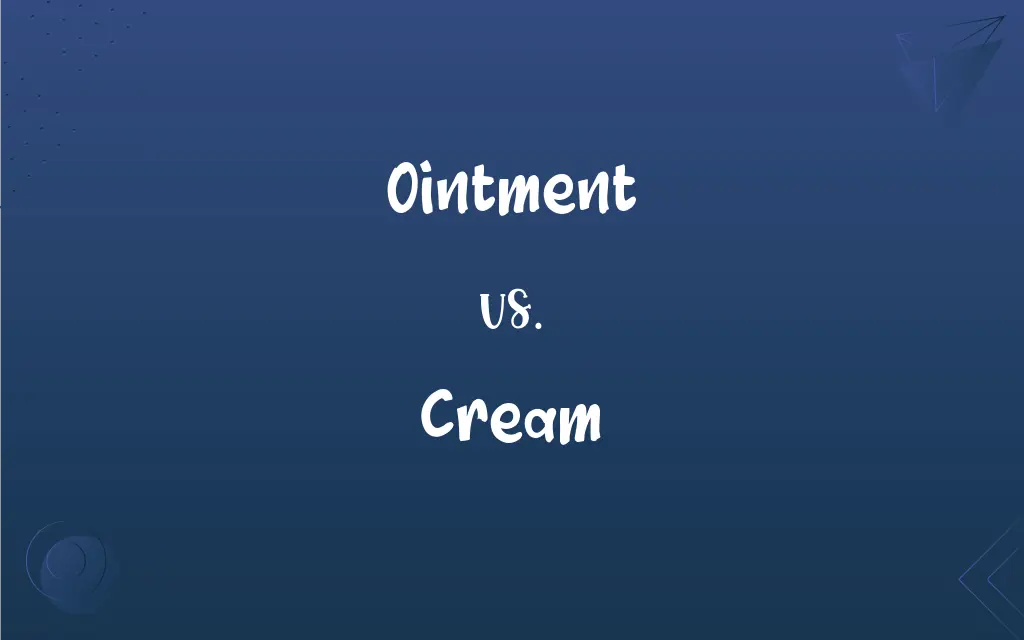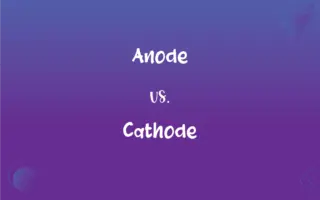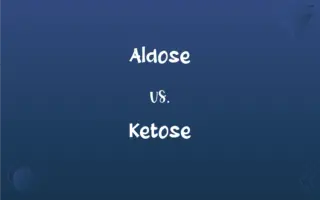Ointment vs. Cream: What's the Difference?
Edited by Aimie Carlson || By Harlon Moss || Updated on October 6, 2023
Ointment is a semi-solid greasy medicinal preparation for external use, while cream is a semi-solid emulsion used either as a medicinal delivery system or a cosmetic product.

Key Differences
Ointment typically embodies a high concentration of oil, distinguishing it significantly from cream. The underlying foundation of an ointment is that it's not only intended to deliver medicinal components but also to create a barrier on the skin. In contrast, cream presents itself as an emulsion of water and oil, known for its capacity to mix both hydrating and moisturizing ingredients.
Exploring the pharmacological landscape, ointment is often advised when a continual, focused medication delivery to the skin is required. On the other side, cream, owing to its lighter, absorbable nature, is often favored for conditions or applications where swift absorption is desired, enabling a rapid onset of action.
From a user-comfort viewpoint, ointment might leave a greasy residue, proving potentially bothersome in daily activities. Cream, conversely, tends to absorb quickly into the skin, leaving a minimal trace of application, which is often appreciated for daytime use where an inconspicuous application might be preferred.
When considering a moisturizing perspective, ointment, with its notably occlusive nature, may provide a formidable barrier, effectively sealing moisture and assisting in skin recovery. Cream, with its balanced blend of oil and water, typically offers a hydrating effect that can be moisturizing without being overly occlusive, beneficial in regular skincare.
In special skin conditions, such as eczema, an ointment might often be recommended due to its ability to protect and hydrate the affected area efficiently. Meanwhile, cream, often enriched with various therapeutic or nourishing ingredients, may be chosen for its therapeutic, soothing, or even aesthetic properties, making it versatile in both medical and cosmetic realms.
ADVERTISEMENT
Comparison Chart
Texture
Greasy and thick
Light and absorbent
Oil Content
High
Varied, often balanced
Usage
Often medicinal, barrier forming
Can be medicinal or cosmetic
Absorption
Slow, forms a layer
Quick, usually does not leave a residue
Skin Feel
Can be heavy or sticky
Typically light and smooth
ADVERTISEMENT
Ointment and Cream Definitions
Ointment
A smooth, thick preparation intended to be applied to the skin for medicinal purposes.
Apply the ointment generously to the affected area.
Cream
A dairy product, rich in fat, obtained by skimming milk.
She poured cream into her coffee.
Ointment
A viscous formulation used to protect or soothe the skin.
The pharmacist recommended a zinc ointment to soothe diaper rash.
Cream
A product designed to add moisture and smoothness to the skin.
The cream left her skin feeling soft and hydrated.
Ointment
A semi-solid substance designed to promote healing of the skin or to provide a barrier.
The doctor prescribed an antibiotic ointment for my burn.
Cream
A thick liquid or semi-solid cosmetic or medical preparation applied to the skin.
She applied a nourishing cream to her face nightly.
Ointment
A medicated formulation intended for topical application.
She used a steroid ointment to reduce inflammation.
Cream
A preparation intended for cleansing, beautifying, promoting attractiveness, or altering the appearance of the skin.
She selected a tinted cream to enhance her complexion.
Ointment
A thick lubricant aiding in reducing friction or providing relief on the surface to which it is applied.
Use the ointment to alleviate chafing during long-distance runs.
Cream
A soft solid or thick liquid containing medicaments or other specific ingredients, applied externally for a prophylactic, therapeutic, or cosmetic purpose.
She used a corticosteroid cream to treat the rash.
Ointment
A highly viscous or semisolid substance used on the skin as a cosmetic, emollient, or medicament; a salve.
Cream
The yellowish fatty component of unhomogenized milk that tends to accumulate at the surface.
Ointment
(medicine) A viscous preparation of oils and/or fats, usually containing medication, used as a treatment or as an emollient.
Cream
Any of various substances resembling or containing cream
Hand cream.
Ointment
A substance used to anoint, as in religious rituals.
Cream
A pale yellow to yellowish white.
FAQs
Why might a cream be preferred for facial application?
Creams are often lighter and absorb quickly, providing moisture without a greasy residue, often preferred for facial applications.
Can ointment and cream be used interchangeably?
Not always, as ointments and creams have distinct formulations and properties which make them suitable for different uses and conditions.
What is an ointment?
Ointment is a semi-solid, greasy preparation typically used for topical medication or protection of the skin.
How does cream differ from ointment in terms of composition?
Cream is a semi-solid emulsion of oil and water, often lighter and more absorbent than the typically oil-heavy ointment.
Is ointment better for dry skin conditions?
Generally, yes. Ointments tend to have higher oil content, providing better moisture retention suitable for dry skin conditions.
Can cream be both a skincare product and a food product?
Yes, cream can refer to a skincare product or a dairy product, with contextual usage defining its meaning.
Why might a healthcare professional recommend ointment for a wound?
Ointments can provide a protective barrier and maintain a moist environment, which is often beneficial for wound healing.
Is cream typically faster to absorb than ointment?
Yes, creams usually absorb into the skin faster than ointments due to their higher water content and lighter texture.
Can ointment be used on all body parts?
While ointments can be used on various body parts, consideration regarding the greasiness and occlusiveness should guide its application.
Should ointment always be applied to a wound or irritated skin?
Not always. The application of ointment should be guided by the specific condition and/or healthcare professional advice.
What is a non-comedogenic cream?
A non-comedogenic cream is formulated to not block pores, reducing the risk of acne and blemishes.
Can ointments cause skin issues if used excessively?
Yes, excessive use of ointments, especially those with active ingredients, might cause skin issues like irritation or worsening of conditions.
Is cream more suitable for sensitive skin?
Cream might be preferred for sensitive skin due to its lighter and less occlusive nature, but specific formulations for sensitive skin are also available.
Why does ointment often feel greasier than cream?
Ointments typically have a higher oil content and less water than creams, resulting in a greasier feel.
Why might ointment be preferred for nighttime use?
Ointments might be preferred at night due to their occlusive nature and potential to leave a greasy residue, which may be less bothersome during sleep.
Can I use a cosmetic cream as a medical treatment?
Cosmetic creams are not a substitute for medical treatments. Always consult healthcare professionals for appropriate medicinal products.
Does the application of ointment last longer than cream?
Often, yes. Ointments tend to stay on the skin longer due to their occlusive, oil-based nature compared to creams.
Is ointment generally more occlusive than cream?
Yes, ointments tend to form a barrier on the skin due to their higher oil content, making them more occlusive than creams.
Can a cream have active medicinal ingredients like an ointment?
Yes, creams can also carry active medicinal ingredients, and their formulation is optimized for quicker skin absorption compared to ointments.
Does cream always provide less effective medication delivery than ointment?
Not necessarily. While ointments often deliver medication over a longer period, creams can be effective for quick absorption and immediate relief.
About Author
Written by
Harlon MossHarlon is a seasoned quality moderator and accomplished content writer for Difference Wiki. An alumnus of the prestigious University of California, he earned his degree in Computer Science. Leveraging his academic background, Harlon brings a meticulous and informed perspective to his work, ensuring content accuracy and excellence.
Edited by
Aimie CarlsonAimie Carlson, holding a master's degree in English literature, is a fervent English language enthusiast. She lends her writing talents to Difference Wiki, a prominent website that specializes in comparisons, offering readers insightful analyses that both captivate and inform.































































